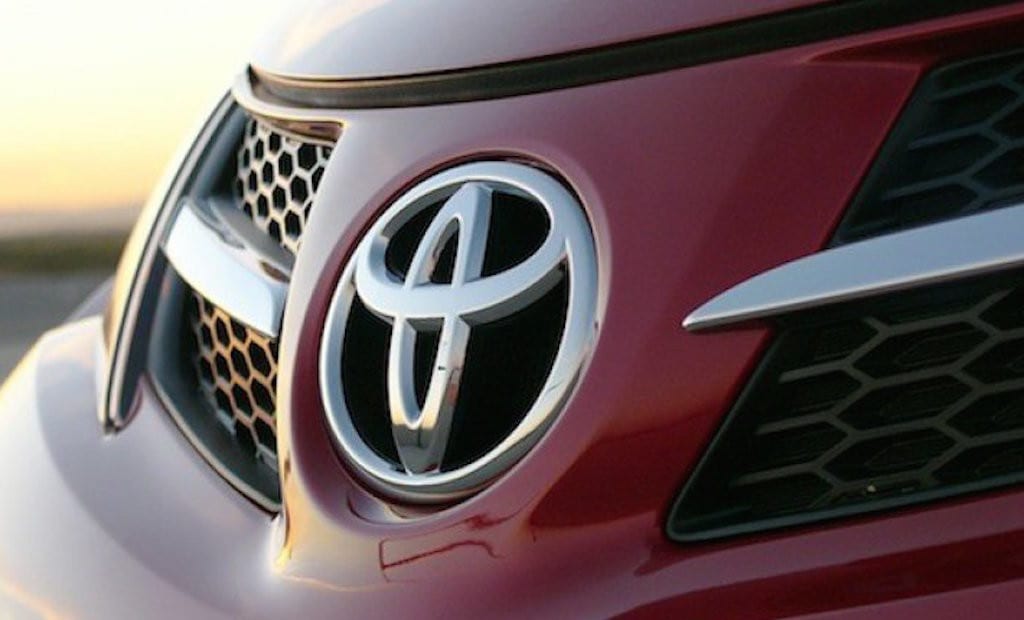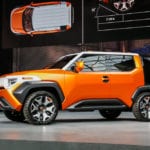If you’re a Toyota enthusiast, you probably often reflect on some of the company’s older and retired models. However, we’d reckon there are a number of vehicles that you’ve just completely forgotten about. Well, here at AutoInfluence, we’re going to make sure that every car is remembered, regardless of how it was received by consumers. Considering how long Toyota has been around (and how many different vehicles they’ve produced), the brand seemed like a natural place to start.
So while the following vehicles may not be what you’d typically find when you’re searching for a Toyota, understand that these cars could potentially be more desirable (based on who you’re talking to). Some of the vehicles are now million-dollar collector items, while some are likely being used on a farm somewhere. Regardless of the current use, let’s take a look at some of the rarest Toyota vehicles…
Toyota Sera
The two-door coupe was available only from 1990 through 1996, and it was only sold to the Japanese market. That didn’t prevent car enthusiasts from around the globe from getting their hands on the impressive vehicle, as the Sera had been imported to the United States, Ireland, Bangladesh, and Sri Lanka, among others. With the name meaning “will be” in French, the intent of the car was to show the company’s futuristic outlook on automobiles.
The most recognizable feature on the Sera was the Lamorghini-esque (as described by Casey Baseel of RocketNews24.com) butterfly doors, as well as an eye-catching glass roof. With an additional glass rear hatch and a rounded body, the vehicle was commended for the excellent visibility. For those worried that an exterior composed mostly of glass would lead to a toasty interior, the company included a pair of removable roof panels on every Sera. Furthermore, the Sera was one of the first cars to include projector headlights up front.
On the inside you’ll find bucket seats up front and bench seats in the back, allowing for four possible passengers. You’d also find the vehicle has right-hand drive, which could be quite the issue if you were looking to import the vehicle from Japan. Major alterations were necessary to make the vehicle legal. However, the company also made sure the changes would not be as drastic as those in other imported vehicles, as the Sera was practically adapted for overseas use.
As Baseel explains, the Sera “featured lackluster performance and handling, and the disharmony of its “look-at-me” styling and absence of driving fun has resulted in it largely fading from memory.” Still, the innovative design still makes it a favorite among car enthusiasts, and you can bet that there are a good number of consumers out there searching the market for a Sera.
Toyota Origin
Baseel writes that the sedan was modeled after the embattled 1950’s Toyota Crown, which was the company’s first exported model. However, the brand inexplicably only made their new Origin available for the 2000 model year. The decision to recreate the Crown was curious in the first place, as the vehicle was considered a “colossal failure in the international market.” With an estimated $70,000 price tag, the car could only pump out 220 horsepower, which was well below the expectations on]f overseas buyers.
The company relied on the Toyota Porgres for the Origin’s platform, and they also borrowed the straight-six DOHC engine. As a throwback to the Origin, the company included rear suicide doors, jewel taillights and a slanting C-pillar. Although it may not have been the intent of the manufacturers, the Origin was considered a luxury car in Japan due to the exterior dimensions and engine displacement. This meant that Japanese drivers were required to pay higher road taxes due to the engine size.
Luckily for the company, they managed to sell 1,000 units, after which production was promptly shut down.
Toyota Sprinter Trueno Convertible
The brand opened up their popular AE86 Hachi Roku Corolla fastback with this model, converting the vehicle into the Sprinter Trueno Convertible. The vehicle never sold particularly well, however, which could be attributed to the hefty price tag (more than twice that of the vehicle it was based on). Furthermore, the convertible was only sold at Toyota Tama dealers, so your everyday car buyer wouldn’t just randomly come across the car and make an impulse buy.
While you’ll still likely find the Sprinter (or even the Sprinter Trueno) on used car lots, it’s unlikely you’ll come across the convertible. If you do, you can take satisfaction in knowing that you’re driving one of the rarest Toyota models ever produced.
Toyota Mega Cruiser
While General Motors used their military Humvee as a basis for their iconic Hummer, Toyota did much the same thing. They look their all-terrain vehicle that was typically used by the Japanese Self Defense Force and released the Mega Cruiser, a street-legal version of the military ride. Sold only in Japan, the vehicle wasn’t particularly popular in the country, as the large frame didn’t mesh with the “narrow roads, tiny parking spaces, and expensive gas,” as Baseel explained. The full-size SUV did end up finding a niche with the police and fire departments, where the large interiors were useful for storing gear.
The 6,270-pound SUV was the largest four-wheel drive vehicle ever produced by the company. The Mega Cruiser included a 4.1-liter turbodiesel I4 engine that could push out a ton of torque at low revs, which was one of the priorities of the engineers. Furthermore, the vehicle had front, center and rear differential locks, and the system also included four-wheel steering.
It wasn’t so much the vehicle that led to a lack of popularity. As we previously mentioned, Toyota’s SUV was much too big for Japanese consumers, and the popularity of the Hummer limited the Mega Cruiser’s sales. The SUV ultimately only lasted from 1995 through 2002.
Toyota 2000GT
The sports car wasn’t necessarily known for it’s performance, although the late-1960’s vehicle was impressive for its time. The car could reach 60 miles per hour in 9.2 seconds, and it hit the quarter mile mark at 16.3 seconds. What truly made the 2000GT so desirable was the stylish body, with a longnose that resembled the E-type vehicles of that time. The interior was luxurious, featuring a much-desired air conditioning unit.
Take a look under the hood, and you’d find a 2.0-liter straight-six engine, which was inspired by the motor in the Toyota Crown sedan. To make the system sportier, Yamaha produced a new double overhead camshaft, allowing for 150 horsepower.
While only 351 2000GTs were sold from 1967 through 1970, appreciation for the vehicle has grown over time. As a result, the rare vehicle now sells for nearly a million dollars in auctions. There was at least one of the sports cars seen driving around Nanto, Japan, but the vehicle met it’s demise when a freak falling tree took out the car.
As we mentioned, you probably wouldn’t find many of the vehicles lying around a used car lot. In fact, you’ll be hard pressed to ever see one of these vehicles at all! They’re all extremely rare and (usually) extremely expensive, meaning it would take a true Toyota fan (who happens to be wealthy) to get some of these vehicles back on the road.
But rarity and uniquity aside, Toyota’s sterling reputation exists on a number of levels, especially when it comes to innovation. In fact, it’s the cornerstone of why they remain such a beloved and iconic brand.
Toyota’s Enduring Popularity
While a number of automakers closed out 2018 by reporting drops in revenue, profit and even the valuation of their stock, a mid-year SWOT analysis of Toyota showed them tracking at a 4.2% increase in US revenue and a 33% increase in profitability over their 2017 numbers. This of course makes it hard to argue their position as (at least one of) the world’s leading automakers.
That said, we opened this article by touching on Toyota’s ability to create quirky vehicles, many of which become rarities as a result, however the aforementioned SWOT analysis revealed certain characteristics that help to set Toyota apart as an enduring industry leader. This includes, but is not limited to…
- R&D First on the list, is Toyotas dedication to the creation of an innovative culture, responsible for some of the most forward-thinking designs and engineering out there. Surpassed only in R&D investment by Volkswagen, the efficiency of Toyota’s spending allows them to match competitors’ revenue while spending less. The fact that they spend more, speaks to their success.
- Recognizability According to Interbrand and Forbes, respectively, Toyota ranks as either the 7th or 9th of the world’s most valuable brands, topping the list in terms of automotive companies alone. To experience that success with a comparatively modest 82-year history is an impressive feat. Factor in countless safety and dependability awards, and the reinforcement of Toyota’s brand strength is almost constant.
While these only paint a partial picture of why Toyota continues to enjoy such forward momentum, year after year, all it takes is peripheral vision to appreciate the impact. Look around any parking lot, or scan the contents of most streets and highways and you’ll inevitably spot an array of Camry, RAV4, Highlanders and Prius (or is ‘Pri-i’ the appropriate plural).
And speaking of the Prius, it’s hard to discount the fact that Toyota lit a proverbial flame under the behind of other automakers with the launch of the hybrid Prius. While it took a few years before the worldwide release in 2000, the Prius’ introduction is a perfect example of Toyota’s forward-thinking strategy and their ability to deliver ahead of any trends. Granted, concerns of ecology were nothing new at the turn of the millennium, but nearly twenty years later, there are several automakers who are still struggling to keep up.
We’d also be remiss if we didn’t draw attention to the evolution of Toyota Safety Sense, a suite of active safety features now offered standard on most new Toyotas. TSS is another example of Toyota being ahead of the curve in standardizing such offerings as:
- Pre-Collision with Pedestrian Detection
- Lane Departure Alert
- Automatic High Beams
- Dynamic Radar Cruise Control
- Road Sign Assist
- Lane Tracking Assist
If you’re interested in learning more about TSS, and see why it was so easy for Toyota to earn their rating as an IIHS Top Safety Pick, visit https://www.toyota.com/safety-sense/animation/lta.
Toyota’s Most Anticipated Offering for 2019
When it comes to attention-grabbing offerings from Toyota, January marks the scheduled unveiling of the 2020 A90 Supra, resurrected as part of a partnership with BMW. While everyone’s still remaining fairly tight-lipped about the Supra at the time that we’re writing this, the expectation of a 335hp coupe with a 0-60mph under five is certainly enticing.
Most importantly though, it’s clear (at least from the array of spy photos wrangled) that the Supra has been designed with Toyota fans in mind. Not entirely dissimilar, in terms of shape from the FT-1 concept displayed back in 2014 in Detroit, the new Supra also takes distinct cues from its A80 predecessor, while creating an aesthetic that’s unique overall. Needless to say, we can’t wait to drink in the details of the reveal.
Toyota’s Most Enticing Concept
And now Toyota seems poised to merge the quirky side of their nature, with the insightful creation of the popular and practical that have cemented their reputation as one of the most reliable and best-selling automakers out there.
Enter the Toyota FT-AC, first introduced as a design concept to the captive audience of the 2017 Los Angeles Auto Show, and making a more corporeal appearance this past November. The FT-AC, or ‘Future Toyota Adventure Concept’ aims to capitalize on the sportier endeavors of today’s special-interest car buyers.
Imagine off-roading or overloading across a foreign terrain, with an endless array of sights to behold. Now, imagine a vehicle whose side-mounted mirrors can capture photos and/or video, aided by an LED roof rack which doubles as a photographic flash. While such tech-centric features could prove difficult to realize in an actual production model, they are no less innovative. It depicts Toyota’s willingness to think outside-the-box while answering demands that no-one ever thought to bring up in the first place. After all, in today’s world of Bluetooth compatibility and smartphone integration, is it really out-of-line to think that a vehicle wouldn’t be able to capture visual documentation as an extension of your wireless devices?
And while that speaks to uniqueness and innovation, the FT-AC’s true quirkiness rests in its overall aesthetic. Presented in a bold tri-tone combination of vibrant green, charcoal and silver, the FT-AC boasts aggressive and unapologetically wild front and rear fascia, with accents that might feel excessive, even with today’s evolving design sensibilities. And yet, it feels both refreshing and on-brand, a faithful extension of Toyota’s design philosophy filtered through the lens of a budget willing to cater to a very specific demographic. Chunky. Rugged. Visionary. The FT-AC feels like something that could actually be placed into production.
And according to Toyota’s GM and Group VP, Jack Hollis, that’s not far from the truth. Comparing the FT-AC to the FJ Cruiser he claims, “Customer feedback was so strong, what did we do? Got the product out in about two years that looked almost identical to the product we brought on on stage. I would put the FT-AC in a similar boat.”
If that’s the case, we’re 100% behind Toyota’s ambitious strategy to bring this all-wheel drive game-changing crossover to realization. The fact that it’s being touted in both a gas-powered and hybrid variant makes it even more intoxicating.
Embracing the Popularity and Possibility
It really doesn’t matter whether we’re talking about Toyota’s storied past of creating models that are quirky in their rarity, or ones that are enduring in their popularity, they have asserted themselves as the kind of automaker who isn’t afraid to make their own footprints.
And, in our opinion, that is a refreshing quality in any automaker. While it’s unfortunate that vehicles have become so mass-produced that they feel inherently less iconic than their classic offerings of yesteryear, its a fearlessness to go off the beaten path that promises something that stands out a bit. And whether you’re looking at such bizarre rarities as the Sera, sporty 2000 GT or innovative FT-AC, you see that sense of fearlessness.
Combine that with Toyota’s awarded and often-celebrated dedication to safety and reliability and its hard not to include them on the list of most fearless automakers out there.










